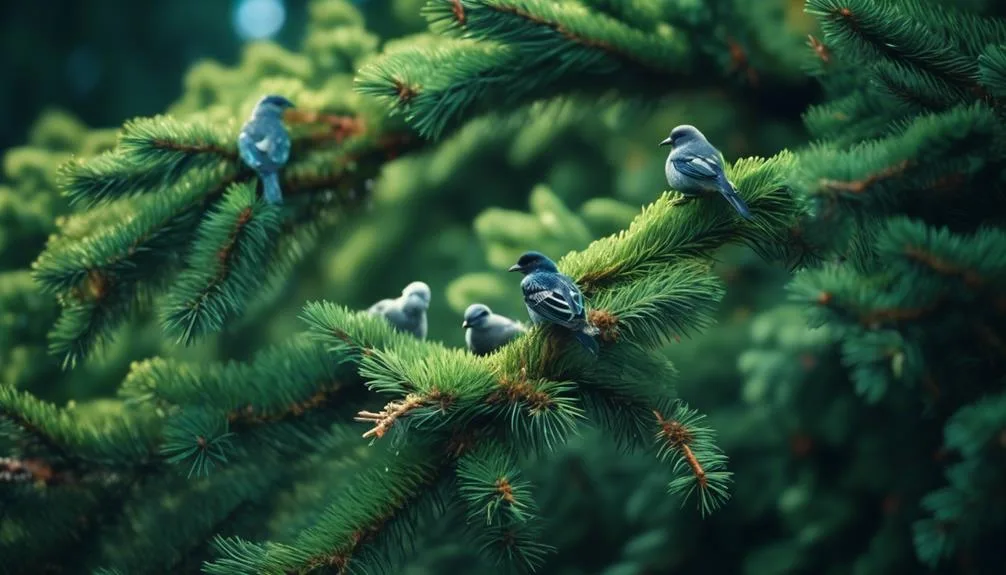Do you ever wonder why birds flock to your spruce tree? It's not just a coincidence. Spruce trees provide birds with shelter, nesting spots, and plenty of food.
But there's more to it than that. Understanding the reasons behind this avian attraction can give you a deeper appreciation for the role your spruce tree plays in the natural world.
Shelter and Nesting Opportunities
Spruce trees provide excellent shelter and nesting opportunities for birds, with their dense foliage and sturdy branches offering protection and security for nesting activities. The unique structure of spruce trees makes them ideal for nesting. Their branches are often arranged in a way that creates a dense network, providing ample hiding spots and protection from predators. This makes it an attractive option for birds to build their nests and raise their young.
Additionally, the natural shape of spruce trees, with their conical form and layered branches, provides a strong foundation for bird nests. The dense foliage also offers a shield from the elements, keeping the nests and eggs safe from harsh weather conditions. These nesting habits make spruce trees a favorite among various bird species, turning them into bustling hubs of avian activity.
Abundance of Food
Nestled among the branches and needles of the spruce trees, a diverse array of insects, seeds, and berries beckon to avian visitors, creating a veritable feast for the birds. The abundance of food sources within the spruce tree ecosystem significantly influences bird behavior and attracts a wide variety of species.
Here's why your spruce tree is a hotspot for bird activity:
- Insects: The dense foliage of spruce trees harbors a plethora of insects, such as caterpillars, beetles, and aphids, which are a vital protein source for many bird species.
- Seeds: Spruce trees produce an abundance of seeds, including pine nuts, which serve as a reliable food source for seed-eating birds like finches and crossbills.
- Berries: Some species of spruce trees bear berries that provide essential nutrition for birds, especially during the winter months.
- Shelter: In addition to food, the dense canopy of spruce trees offers shelter and protection for birds, making it an attractive habitat year-round.
Protection From Predators
Amidst the lush greenery of the spruce tree canopy, a network of branches and foliage provides a shield from predators, offering a secure refuge for the avian inhabitants. The dense and evergreen nature of spruce trees provides excellent camouflage benefits for birds, allowing them to blend seamlessly with the surroundings, making it difficult for predators to spot them. The safety advantages of nesting in a spruce tree are further enhanced by the height and sturdy structure of the tree, which makes it challenging for ground-based predators to access the nests. Additionally, the thick branches and needles of the spruce tree create a barrier that discourages aerial predators from reaching the nests. This natural protection fosters a safe environment for birds to thrive and raise their young.
| Camouflage Benefits | Safety Advantages |
|---|---|
| Blending in with surroundings | Height and sturdy structure |
| Concealment from predators | Discouraging aerial predators |
Attraction to Evergreen Foliage
Among the many attractive features of spruce trees for birds, the evergreen foliage holds a special allure, providing not only shelter but also a reliable food source and nesting material.
- Winter foraging: The evergreen needles of spruce trees offer a vital food source for birds during the winter months when other food may be scarce. Birds are attracted to the seeds found in the cones and the insects that seek refuge in the tree's foliage.
- Camouflage benefits: The dense, dark green needles of spruce trees provide excellent camouflage for birds, allowing them to blend into the surroundings and remain hidden from predators. This protective cover gives birds a sense of security while foraging and nesting.
- Nesting material: Birds use the evergreen needles and branches of spruce trees to build their nests, taking advantage of the tree's sturdy and reliable structure to protect their offspring.
- Shelter: The thick, year-round coverage provided by evergreen foliage offers birds protection from the elements, including wind, rain, and snow.
Role in Supporting Bird Populations
The presence of spruce trees in an area significantly contributes to the support and sustenance of local bird populations, fostering a thriving ecosystem.
Spruce trees play a vital role in biodiversity conservation by providing a habitat for a diverse range of bird species. These trees offer nesting sites, protection from predators, and a valuable food source, which are crucial for maintaining ecological balance.
Furthermore, spruce forests aid in habitat restoration, especially in areas where natural habitats have been disrupted. This restoration not only benefits the birds but also contributes to the overall health of the ecosystem.
Additionally, the presence of spruce trees can attract birdwatching tourism, offering enthusiasts the opportunity to observe a variety of bird species in their natural habitat.
As a result, spruce trees not only beautify the landscape but also play a significant role in supporting and preserving bird populations.
Conclusion
In supporting bird populations and contributing to the ecosystem, your spruce tree serves as a valuable asset to your backyard.
Its dense branches offer shelter and nesting opportunities, abundant food sources, and protection from predators, making it an attractive haven for birds.
This symbiotic relationship highlights the interconnectedness of nature and the importance of preserving habitats for wildlife.

My interest in trees started when I first saw the giant sequoias in Yosemite.
I was a teenager then, and I remember thinking, “I need to learn more about this.”
That moment stuck with me.
A few years later, I went on to study forestry at Michigan Tech.
Since graduating, I’ve worked in a mix of hands-on tree care and community education.
I’ve spent over ten years helping people understand how to plant, maintain, and protect the trees in their neighborhoods.
I don’t see trees as just part of the landscape.
They are living things that make a real difference in our daily lives.
